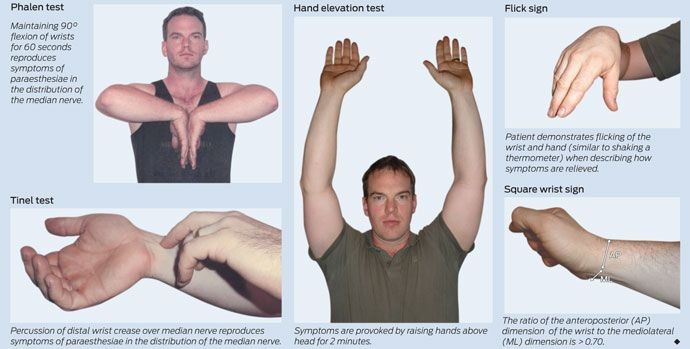
Contents
- 1 How Do I Know If It’s Carpal Tunnel or Arthritis?
- 1.0.1 Tests to determine carpal tunnel syndrome
- 1.0.2 Tests done to diagnose arthritis
- 1.0.3 What is carpal tunnel syndrome?
- 1.0.4 9 symptoms of carpal tunnel syndrome
- 1.0.5 What is arthritis?
- 1.0.6 19 symptoms of arthritis
- 1.0.7 Subscribe to MedicineNet’s Arthritis Newsletter
- 1.0.8 Can there be any association between carpal tunnel syndrome and arthritis?
- 1.0.9 From
How Do I Know If It’s Carpal Tunnel or Arthritis?
Carpal tunnel syndrome is caused by median nerve compression and does not cause arthritis.
Both Carpal tunnel syndrome and arthritis cause wrist pain, loss of grip, and deterioration in hand strength. It is crucial to determine the source of hand impairment for appropriate treatment.
Carpal tunnel syndrome and arthritis have different causes; thus, they manifest differently in the hand. It is challenging to distinguish between carpal tunnel syndrome and arthritis.
To diagnose, your doctor may perform a physical examination, radiological tests, and neurological evaluation, which can help determine the cause of the impairment.
Tests to determine carpal tunnel syndrome
Physical examinations
A thorough examination of your hand, wrist, shoulder, and neck is done to rule out other reasons for nerve pressure. Your doctor checks for soreness, swelling, and abnormalities in your wrists. They also examine the feeling in your fingers and the strength of your hand muscles.
- Tinel’s sign: The doctor taps the median nerve at the wrist to check for tingling in the fingers.
- Wrist flexion test (or Phalen test): This test involves resting your elbows on a table and allowing the wrist to slide forward freely. If you have carpal tunnel syndrome, you may experience numbness and tingling in your fingers within 60 seconds. Symptoms worsen as the severity of carpal tunnel syndrome increases.
- Two-point discrimination test: This test is performed when severe carpal tunnel syndrome is suspected. Your doctor asks you to close your eyes and then touches two places on your hand or finger that are relatively close together using small devices. In severe carpal tunnel syndrome, you may not be able to distinguish between the two touches, making it appear as though only one spot is being touched.
Radiological tests
- X-rays: If you have restricted wrist motion or pain, your doctor may request X-rays to rule out other possible causes such as arthritis, ligament damage, or a fracture.
- Magnetic resonance imaging (MRI): MRI scans are more accurate than X-rays in capturing pictures of the body’s soft tissues. An MRI may be ordered by your doctor to evaluate possible causes of your symptoms or search for abnormal tissues affecting the median nerve. It can help determine whether there are any issues with the nerve itself, such as a tumor or scarring.
- Ultrasound: Ultrasound imaging uses high-frequency sound waves to make images of bone and tissue. Your doctor may advise you to get an ultrasound of your wrist to check for evidence of median nerve compression.
Electrophysiological tests
- Nerve conduction studies: These tests assess the speed at which your nerve impulses travel. Carpal tunnel syndrome occurs when the nerve impulse is slower than normal in the hand.
- Electromyography (EMG): An EMG test detects the electrical activity in muscles. EMG measures the function of the median nerve and reveals the presence of nerve or muscle damage.
Tests done to diagnose arthritis
Physical examination
Your doctor will inquire about your symptoms and how joint discomfort affects your daily life. They will perform a physical exam, which may include:
- Assessing joint mobility and range of motion
- Examining your joints for soreness or swelling
- Evaluating your general health to determine if another issue is affecting your symptoms
Radiological tests
Imaging exams provide a detailed view of your bones, joints, and soft tissues. X-rays, magnetic resonance imaging, and ultrasounds can reveal:
- Joint discomfort caused by bone fractures or dislocations
- Degeneration of cartilage surrounding your joints
- Injuries to your muscles, ligaments, or tendons around your joints
- Inflammation of soft tissues
Blood tests
No blood test can identify arthritis. However, if your doctor suspects gout or rheumatoid arthritis, you may undergo blood tests to look for Rh factor or anticyclic citrullinated peptide (anti-CCP) antibodies. They may measure blood uric acid levels and inflammatory proteins.
Patients with rheumatoid arthritis may have high erythrocyte sedimentation rate or C-reactive protein levels, indicating an inflammatory process in the body.
If blood tests reveal high uric acid levels, you may have gout. However, high uric acid does not necessarily indicate gout; clinical signs are considered for diagnosis.
What is carpal tunnel syndrome?
Carpal tunnel syndrome causes tingling, numbness, and discomfort in the hand and forearm. The median nerve provides sensory intervention to the palm and fingers, except for the pinky finger and half of the ring finger. If the median nerve is compressed in the wrist, it leads to carpal tunnel syndrome.
Carpal tunnel syndrome worsens over time. If left untreated, it can result in irreversible hand dysfunction, including loss of feeling and weakening. Detecting and treating carpal tunnel syndrome as soon as possible is crucial.
Early symptoms can be addressed through simple actions such as:
- Sleeping with a wrist splint
- Exercises to keep the nerve mobile
- Avoiding activities that worsen symptoms
- Injection of steroids into the carpal tunnel
However, continued pressure on the median nerve can result in nerve injury and worsened symptoms. In some cases, surgery may be performed to relieve pressure on the median nerve and prevent permanent damage.
9 symptoms of carpal tunnel syndrome
- Numbness, burning, and discomfort in all the fingers except the pinky finger; this often occurs at night
- Tingling sensation in the fingertips
- Reduced sensation in the fingers
- Shock-like feelings in the thumb, index, middle, and ring fingers
- Tingling or pain that travels up the forearm toward the shoulder
- Feeling of swelling in the fingers
- Hand weakness and clumsiness, making fine actions difficult
- Dropping objects due to muscle weakness and loss of grip
- Difficulty using the hand for tasks such as handling small objects, driving, holding a book, writing, and using a computer keyboard
What is arthritis?
Arthritis is inflammation of joints and can affect any bone in the body. Commonly affected are weight-bearing joints like the hip, knee, and spine, but it can also affect non-weight-bearing joints such as the fingers.
Inflammation of joints causes pain, redness, and swelling. Without treatment, inflammation can lead to significant and sometimes irreversible damage, resulting in loss of function and impairment.
Arthritis includes various disorders such as osteoarthritis, rheumatoid arthritis, and inflammatory arthritis. These disorders cause inflammation in the joints or other parts of the body.
19 symptoms of arthritis
- Inflammation of the joints
- Pain, stiffness, and tenderness of the joints
- Joint stiffness that worsens in the mornings and after inactivity
- Swelling and warm skin over the affected joint
- Red eyes and mouth ulcers
- Reduced range of motion
- Loss of appetite
- Restricted range of motion that improves with movement
- Clicking or popping with bending
- Muscular weakness around the joint
- Joint instability
- Bony growths in the fingers
- Grating or scraping sensation in the knees
- Morning stiffness that lasts at least 30 minutes, starting in smaller joints
- Both sides of the body affected by the same joints
- Fatigue
- Fever
- Inflammation of the heart muscle and blood vessels
- Low red blood cell count
Subscribe to MedicineNet’s Arthritis Newsletter
By clicking "Submit," I agree to the MedicineNet Terms and Conditions and Privacy Policy. I also agree to receive emails from MedicineNet and understand that I may opt out of subscriptions at any time.
Can there be any association between carpal tunnel syndrome and arthritis?
Carpal tunnel syndrome is caused by median nerve compression and does not cause arthritis. On the other hand, arthritis can produce inflammation and swelling in the tissue around the affected joints.
Compression of the median nerve in carpal tunnel syndrome is caused by structural abnormalities, thickening of the tendinous band, repeated friction, or nerve swelling. Arthritis can lead to changes that compress the median nerve, including:
- Bone projections secondary to arthritis in the small bones of the wrist around the carpal tunnel
- Swelling in the wrist
- Swelling of the tendons in the carpal tunnel
From
Arthritis Resources
- Inside the Visit With a Rheumatologist
- PsA Treatment Not Working? Red Flags to Know
Featured Centers
- What Are the Best PsA Treatments for You?
- Understanding Biologics
- 10 Things People With Depression Wish You Knew


